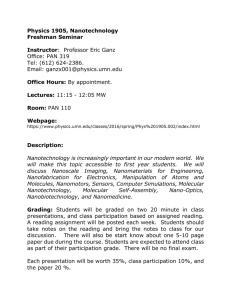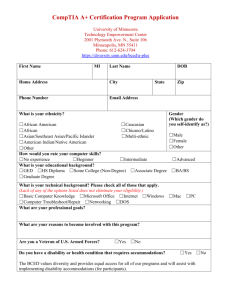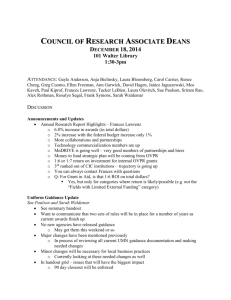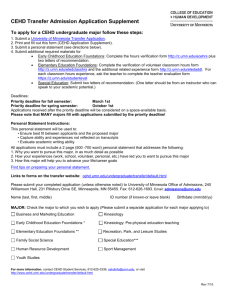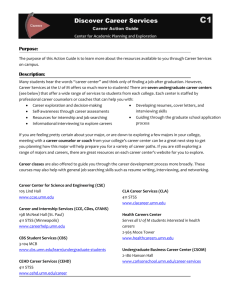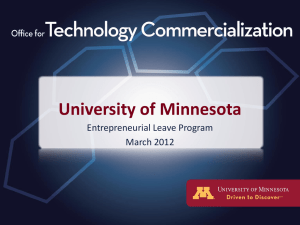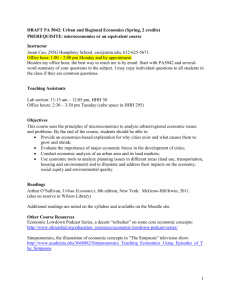PubH-6915_Nutrition-Assessment_Fall 2015
advertisement
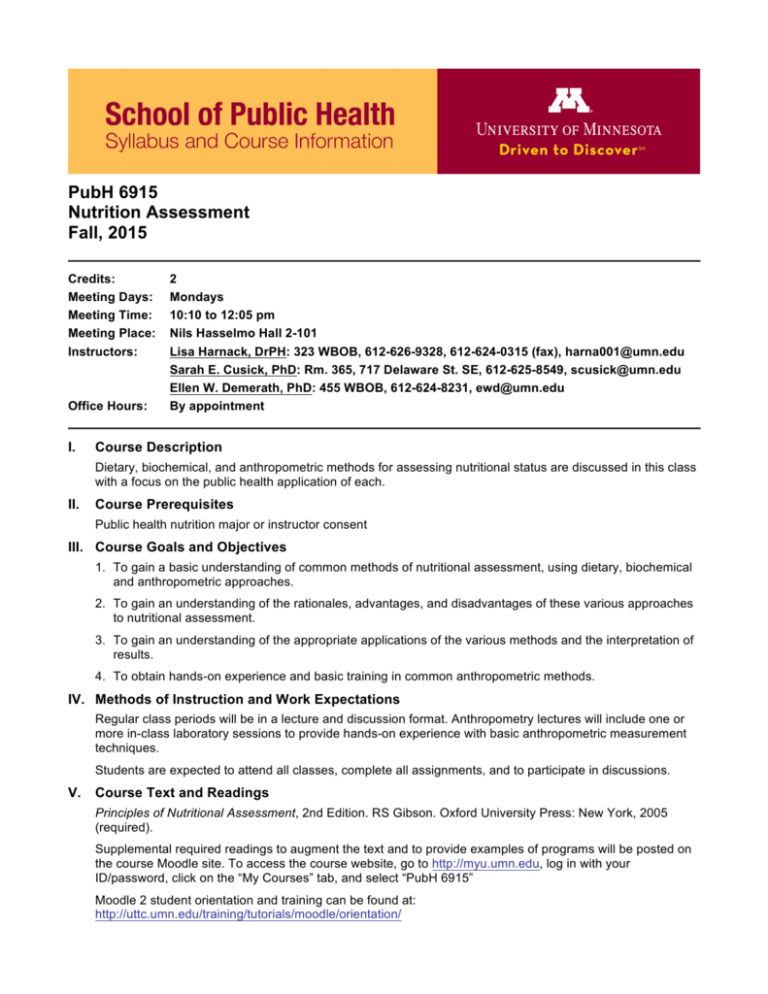
PubH 6915 Nutrition Assessment Fall, 2015 Credits: Meeting Days: Meeting Time: Meeting Place: Instructors: Office Hours: I. 2 Mondays 10:10 to 12:05 pm Nils Hasselmo Hall 2-101 Lisa Harnack, DrPH: 323 WBOB, 612-626-9328, 612-624-0315 (fax), harna001@umn.edu Sarah E. Cusick, PhD: Rm. 365, 717 Delaware St. SE, 612-625-8549, scusick@umn.edu Ellen W. Demerath, PhD: 455 WBOB, 612-624-8231, ewd@umn.edu By appointment Course Description Dietary, biochemical, and anthropometric methods for assessing nutritional status are discussed in this class with a focus on the public health application of each. II. Course Prerequisites Public health nutrition major or instructor consent III. Course Goals and Objectives 1. To gain a basic understanding of common methods of nutritional assessment, using dietary, biochemical and anthropometric approaches. 2. To gain an understanding of the rationales, advantages, and disadvantages of these various approaches to nutritional assessment. 3. To gain an understanding of the appropriate applications of the various methods and the interpretation of results. 4. To obtain hands-on experience and basic training in common anthropometric methods. IV. Methods of Instruction and Work Expectations Regular class periods will be in a lecture and discussion format. Anthropometry lectures will include one or more in-class laboratory sessions to provide hands-on experience with basic anthropometric measurement techniques. Students are expected to attend all classes, complete all assignments, and to participate in discussions. V. Course Text and Readings Principles of Nutritional Assessment, 2nd Edition. RS Gibson. Oxford University Press: New York, 2005 (required). Supplemental required readings to augment the text and to provide examples of programs will be posted on the course Moodle site. To access the course website, go to http://myu.umn.edu, log in with your ID/password, click on the “My Courses” tab, and select “PubH 6915” Moodle 2 student orientation and training can be found at: http://uttc.umn.edu/training/tutorials/moodle/orientation/ VI. Course Outline/Weekly Schedule Date Session Sept 14 1a Introduction to biochemical assessment 1b Lipids 2a Vitamin A 477-497 2b Iron 443-476 Looker 3a Folic acid and B12 595-640 Pfeiffer 3b Zinc and Iodine 711-731; Sept 21 Sept 28 Topic Text Readings 373-402 Arab 749-766 Oct 5 4a Antioxidants: Cartenoids,vitamin E, vitamin C 508-516; 529-554 Canfield 4b Vitamin D and calcium 497-508; 641-657 Prentice 5a Using and interpreting nutritional biomarkers 6a Overview of dietary assessment methods 6b 6c Food record and dietary recalls 7a Day-to-day variation in diet 7b Food frequency questionnaires 8a Practice choosing methods 8b 8c Meal observation and plate waste New methods under development Illner 9a Measure of the food environment McKinnon 9b Practice choosing methods 10a 10b Dietary supplement use assessment Food and nutrient database considerations Assign. 2 due 10c Quality assurance Nov. 23 11a Rationale for anthropometric assessment 233-244 11b Stature and weight and its indicators (in-class lab) 245-272 12a Subcutaneous fat and circumferences (in class lab) 273-298 12b Body composition 353-372 13 Reference data; cut-offs and community indicators 299-334; WHO, 2006 335-352; 247-261 Ziegler, 2012 Woodruff, 2002 Oct 12 Assign 1 Due Oct 19 Oct 26 Nov 2 Nov 9 Nov 16 Nov. 30 Dec.7 Dec. 14 14 41-64 Under reporting 129-148 Kristal 105-128 Anthropometric assessment in special populations Assign. 3 due 65-90 Ogden, 2014 Himes, 2009 Demerath, 2014 Chumlea, 1998 Readings Unit 1: Biochemical Assessment Arab L. Biomarkers of fat and fatty acid intake. J Nutr. 2003;133:925S-932S. 2 Canfield LM, Bulux J, Quan de Serrano J, Rivera C, Lima AF, Lopez CY, Perez R, Khan LK, Harrison GG, Solomons NW. Plasma response to oral beta-carotene in Guatemalan schoolchildren. Am J Clin Nutr. 1991 Sep;54(3):539-547. Looker AC, Dallman PR, Carroll MD, Gunter EW, Johnson CL. Prevalence of iron deficiency in the United States. JAMA. 1997;277(12):973-976 Pfeiffer CM, Johnson CL, Jain RB, et al. Trends in blood folate and vitamin B-12 concentrations in the United States, 1988-2004. Am J Clin Nutr. 2007; 86:718-27. Prentice A, Goldberg GR, Schoenmakers I. Vitamin D across the lifecycle: physiology and biomarkers. Am J Clin Nutr. 2008 Aug;88(2):500S-506S. Unit 2: Dietary Assessment Illner, AK, Freisling H, Boeing H, Huybrechts I, Crispim SP, Slimani N. Review and evaluation of innovative technologies for measuring diet in nutritional epidemiology. International Journal of Epidemiology. 2012;41:1187-1203. Kristal AR, Peters U, Potter JD. Is it time to abandon the food frequency questionnaire? Cancer Epidemiol Biomarkers Prev. 2005;14(12):2826-2828. McKinnon RA, Reedy J, Morrissette MA, Lytle LA, Yaroch AL. Measures of the food environment: A compilation of the literature, 1990-2007. American Journal of Preventive Medicine. 2009;36(4S): S124-S133. Unit 3: Anthropometric Assessment Chumlea WC, Guo SS, Wholihan K, Cockram D, Kuczmarski RJ, Johnson CL. Stature prediction equations for elderly non-Hispanic white, non-Hispanic black, and Mexican-American persons developed from NHANES III data. J Am Diet Assoc. 1998 Feb;98(2):137-42. Demerath EW, Fields DA. Body composition assessment in the infant. Am J Hum Biol. 2014 MayJun;26(3):291-304. doi: 10.1002/ajhb.22500. Epub 2014 Jan 15. Himes JH, Park K, Styne D. Menarche and assessment of body mass index in adolescent girls. J Pediatr. 2009;155:393-397. Ogden CL, Carroll MD, Kit BK, Flegal KM. Prevalence of childhood and adult obesity in the United States, 2011-2012. JAMA. 2014 Feb 26;311(8):806-14. doi: 10.1001/jama.2014.732. WHO Multicentre Growth Reference Study Group. WHO Child Growth Standards based on length/height, weight and age. Acta Paediatr Suppl. 2006 Apr;450:76-85. Woodruff BA, Duffield A. Anthropometric assessment of nutritional status in adolescent populations in humanitarian emergencies. Eur J Clin Nutr. 2002 Nov;56(11):1108-18. Ziegler EE1, Nelson SE. The WHO growth standards: strengths and limitations. Curr Opin Clin Nutr Metab Care. 2012 May;15(3):298-302. doi: 10.1097/MCO.0b013e3283511478. 3 Assignments / Examinations 1. A 3-page take-home evaluation of a journal article including biochemical/laboratory indicators (due Oct 12). 2. A take-home series of short essay questions designed to build students’ skills in selecting dietary assessment methods for specific objectives and population groups (due Nov 16). 3. A short take-home critique (3 pages) of a journal article (of the student’s choosing) regarding appropriateness of use of anthropometry, e.g., rationales for measurements, measurement protocols, reliability and validity, reference data, cut-offs, and interpretation of results (due Dec. 14). 4. A take-home final examination asking students to propose an integrated nutrition assessment plan, incorporating dietary, biochemical, and anthropometric methods in response to a hypothetical situation and problem (due Dec. 21). Scores on exams received after the due date will be reduced for each day late. No exams will be accepted more than three days late, and a zero will be assigned. In-Class Anthropometry Laboratory Each student will participate in in-class laboratory sessions for practical aspects of anthropometric methods. During each lab students will be trained in anthropometric protocols and complete practical exercises focusing on commonly used methods and measurement reliability. The lab exercises will be turned in at the end of class. The labs will be held in same room as the lecture. Students will be measuring each other. Please wear a top that is sleeveless or with loose short sleeves, and shorts, if possible. VII. Evaluation and Grading Assignment numbers 1-3 will each be worth 20% and the final examination will be worth 40% toward the final grade. The University utilizes plus and minus grading on a 4.000 cumulative grade point scale in accordance with the following: A 4.000 – Represents achievement that is outstanding relative to the level necessary to meet course requirements A- 3.667 B+ 3.333 B 3.000 – Represents achievement that is significantly above the level necessary to meet course requirements B- 2.667 C+ 2.333 C 2.000 – Represents achievement that meets the course requirements in every respect C- 1.667 D+ 1.333 D 1.000 - Represents achievement that is worthy of credit even though it fails to meet fully the course requirements S Represents achievement that is satisfactory, which is equivalent to a C- or better. For additional information, please refer to: http://policy.umn.edu/Policies/Education/Education/GRADINGTRANSCRIPTS.html. Course Evaluation The SPH will collect student course evaluations electronically using a software system called CoursEval: www.sph.umn.edu/courseval. The system will send email notifications to students when they can access and complete their course evaluations. Students who complete their course evaluations promptly will be able to access their final grades just as soon as the faculty member renders the grade in SPHGrades: www.sph.umn.edu/grades. All students will have access to their final grades through OneStop two weeks 4 after the last day of the semester regardless of whether they completed their course evaluation or not. Student feedback on course content and faculty teaching skills are an important means for improving our work. Please take the time to complete a course evaluation for each of the courses for which you are registered. Incomplete Contracts A grade of incomplete “I” shall be assigned at the discretion of the instructor when, due to extraordinary circumstances (e.g., documented illness or hospitalization, death in family, etc.), the student was prevented from completing the work of the course on time. The assignment of an “I” requires that a contract be initiated and completed by the student before the last official day of class, and signed by both the student and instructor. If an incomplete is deemed appropriate by the instructor, the student in consultation with the instructor, will specify the time and manner in which the student will complete course requirements. Extension for completion of the work will not exceed one year (or earlier if designated by the student’s college). For more information and to initiate an incomplete contract, students should go to SPHGrades at: www.sph.umn.edu/grades. University of Minnesota Uniform Grading and Transcript Policy A link to the policy can be found at onestop.umn.edu. VIII. Other Course Information and Policies Grade Option Change (if applicable) For full-semester courses, students may change their grade option, if applicable, through the second week of the semester. Grade option change deadlines for other terms (i.e. summer and half-semester courses) can be found at onestop.umn.edu. Course Withdrawal Students should refer to the Refund and Drop/Add Deadlines for the particular term at onestop.umn.edu for information and deadlines for withdrawing from a course. As a courtesy, students should notify their instructor and, if applicable, advisor of their intent to withdraw. Student Conduct, Scholastic Dishonesty and Sexual Harassment Policies The University seeks an environment that promotes academic achievement and integrity, that is protective of free inquiry, and that serves the educational mission of the University. Similarly, the University seeks a community that is free from violence, threats, and intimidation; that is respectful of the rights, opportunities, and welfare of students, faculty, staff, and guests of the University; and that does not threaten the physical or mental health or safety of members of the University community. As a student at the University you are expected adhere to Board of Regents Policy: Student Conduct Code. To review the Student Conduct Code, please see: http://regents.umn.edu/sites/default/files/policies/Student_Conduct_Code.pdf. Note that the conduct code specifically addresses disruptive classroom conduct, which means "engaging in behavior that substantially or repeatedly interrupts either the instructor's ability to teach or student learning. The classroom extends to any setting where a student is engaged in work toward academic credit or satisfaction of program-based requirements or related activities." Use of Personal Electronic Devices in the Classroom: Using personal electronic devices in the classroom setting can hinder instruction and learning, not only for the student using the device but also for other students in the class. To this end, the University establishes the right of each faculty member to determine if and how personal electronic devices are allowed to be used in the classroom. For complete information, please reference: http://policy.umn.edu/Policies/Education/Education/STUDENTRESP.html. Scholastic Dishonesty: You are expected to do your own academic work and cite sources as necessary. Failing to do so is scholastic dishonesty. Scholastic dishonesty means plagiarizing; cheating on assignments or examinations; engaging in unauthorized collaboration on academic work; taking, acquiring, or using test materials without faculty permission; submitting false or incomplete records of academic achievement; acting alone or in cooperation with another to falsify records or to obtain dishonestly grades, honors, awards, or professional endorsement; altering, forging, or misusing a University academic record; or fabricating or falsifying data, research procedures, or data analysis. (Student Conduct Code: 5 http://regents.umn.edu/sites/default/files/policies/Student_Conduct_Code.pdf) If it is determined that a student has cheated, he or she may be given an "F" or an "N" for the course, and may face additional sanctions from the University. For additional information, please see: http://policy.umn.edu/Policies/Education/Education/INSTRUCTORRESP.html. The Office for Student Conduct and Academic Integrity has compiled a useful list of Frequently Asked Questions pertaining to scholastic dishonesty: http://www1.umn.edu/oscai/integrity/student/index.html. If you have additional questions, please clarify with your instructor for the course. Your instructor can respond to your specific questions regarding what would constitute scholastic dishonesty in the context of a particular class-e.g., whether collaboration on assignments is permitted, requirements and methods for citing sources, if electronic aids are permitted or prohibited during an exam. Makeup Work for Legitimate Absences: Students will not be penalized for absence during the semester due to unavoidable or legitimate circumstances. Such circumstances include verified illness, participation in intercollegiate athletic events, subpoenas, jury duty, military service, bereavement, and religious observances. Such circumstances do not include voting in local, state, or national elections. For complete information, please see: http://policy.umn.edu/Policies/Education/Education/MAKEUPWORK.html. Appropriate Student Use of Class Notes and Course Materials: Taking notes is a means of recording information but more importantly of personally absorbing and integrating the educational experience. However, broadly disseminating class notes beyond the classroom community or accepting compensation for taking and distributing classroom notes undermines instructor interests in their intellectual work product while not substantially furthering instructor and student interests in effective learning. Such actions violate shared norms and standards of the academic community. For additional information, please see: http://policy.umn.edu/Policies/Education/Education/STUDENTRESP.html. Sexual Harassment "Sexual harassment" means unwelcome sexual advances, requests for sexual favors, and/or other verbal or physical conduct of a sexual nature. Such conduct has the purpose or effect of unreasonably interfering with an individual's work or academic performance or creating an intimidating, hostile, or offensive working or academic environment in any University activity or program. Such behavior is not acceptable in the University setting. For additional information, please consult Board of Regents Policy: http://regents.umn.edu/sites/default/files/policies/SexHarassment.pdf Equity, Diversity, Equal Opportunity, and Affirmative Action: The University will provide equal access to and opportunity in its programs and facilities, without regard to race, color, creed, religion, national origin, gender, age, marital status, disability, public assistance status, veteran status, sexual orientation, gender identity, or gender expression. For more information, please consult Board of Regents Policy: http://regents.umn.edu/sites/default/files/policies/Equity_Diversity_EO_AA.pdf. Disability Accommodations: The University of Minnesota is committed to providing equitable access to learning opportunities for all students. The Disability Resource Center Student Services is the campus office that collaborates with students who have disabilities to provide and/or arrange reasonable accommodations. If you have, or think you may have, a disability (e.g., mental health, attentional, learning, chronic health, sensory, or physical), please contact DRC at 612-626-1333 or ds@umn.edu to arrange a confidential discussion regarding equitable access and reasonable accommodations. If you are registered with DS and have a current letter requesting reasonable accommodations, please contact your instructor as early in the semester as possible to discuss how the accommodations will be applied in the course. For more information, please see the DS website, https://diversity.umn.edu/disability/. Mental Health and Stress Management: As a student you may experience a range of issues that can cause barriers to learning, such as strained relationships, increased anxiety, alcohol/drug problems, feeling down, difficulty concentrating and/or lack of 6 motivation. These mental health concerns or stressful events may lead to diminished academic performance and may reduce your ability to participate in daily activities. University of Minnesota services are available to assist you. You can learn more about the broad range of confidential mental health services available on campus via the Student Mental Health Website: http://www.mentalhealth.umn.edu. The Office of Student Affairs at the University of Minnesota: The Office for Student Affairs provides services, programs, and facilities that advance student success, inspire students to make life-long positive contributions to society, promote an inclusive environment, and enrich the University of Minnesota community. Units within the Office for Student Affairs include, the Aurora Center for Advocacy & Education, Boynton Health Service, Central Career Initiatives (CCE, CDes, CFANS), Leadership Education and Development – Undergraduate Programs (LEAD-UP), the Office for Fraternity and Sorority Life, the Office for Student Conduct and Academic Integrity, the Office for Student Engagement, the Parent Program, Recreational Sports, Student and Community Relations, the Student Conflict Resolution Center, the Student Parent HELP Center, Student Unions & Activities, University Counseling & Consulting Services, and University Student Legal Service. For more information, please see the Office of Student Affairs at http://www.osa.umn.edu/index.html. Academic Freedom and Responsibility: for courses that do not involve students in research: Academic freedom is a cornerstone of the University. Within the scope and content of the course as defined by the instructor, it includes the freedom to discuss relevant matters in the classroom. Along with this freedom comes responsibility. Students are encouraged to develop the capacity for critical judgment and to engage in a sustained and independent search for truth. Students are free to take reasoned exception to the views offered in any course of study and to reserve judgment about matters of opinion, but they are responsible for learning the content of any course of study for which they are enrolled.* Reports of concerns about academic freedom are taken seriously, and there are individuals and offices available for help. Contact the instructor, the Department Chair, your adviser, the associate dean of the college (Dr Kristin Anderson, SPH Dean of Student Affairs), or the Vice Provost for Faculty and Academic Affairs in the Office of the Provost. * Language adapted from the American Association of University Professors "Joint Statement on Rights and Freedoms of Students". Student Academic Success Services (SASS): http://www.sass.umn.edu: Students who wish to improve their academic performance may find assistance from Student Academic Support Services. While tutoring and advising are not offered, SASS provides resources such as individual consultations, workshops, and self-help materials. 7
